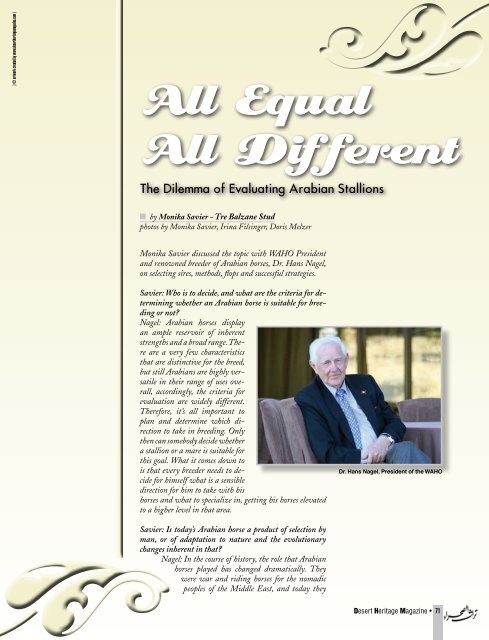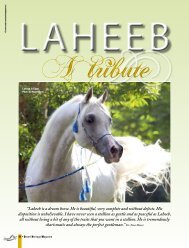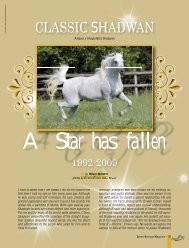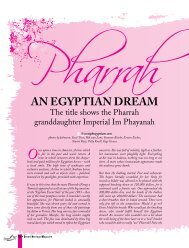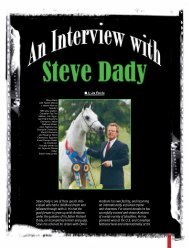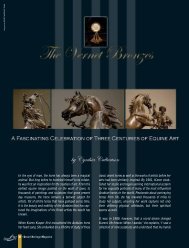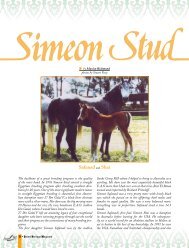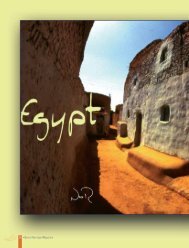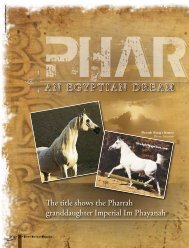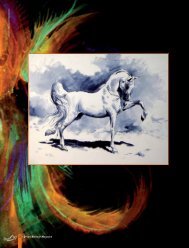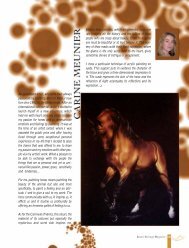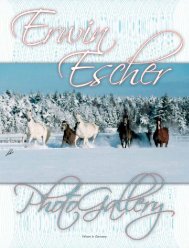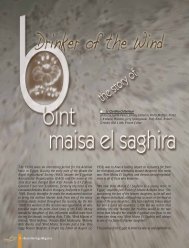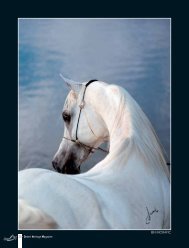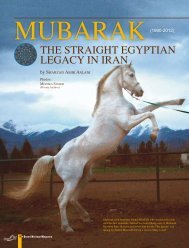Dr. Hans Nagel - Desertheritagemagazine.com desert heritage ...
Dr. Hans Nagel - Desertheritagemagazine.com desert heritage ...
Dr. Hans Nagel - Desertheritagemagazine.com desert heritage ...
Create successful ePaper yourself
Turn your PDF publications into a flip-book with our unique Google optimized e-Paper software.
) © artwork created by www.<strong>desert</strong><strong>heritage</strong>magazine.<strong>com</strong> (<br />
All Equal<br />
All Different<br />
The Dilemma of Evaluating Arabian Stallions<br />
n by Monika Savier - Tre Balzane Stud<br />
photos by Monika Savier, Irina Filsinger, Doris Melzer<br />
Monika Savier discussed the topic with WAHO President<br />
and renowned breeder of Arabian horses, <strong>Dr</strong>. <strong>Hans</strong> <strong>Nagel</strong>,<br />
on selecting sires, methods, flops and successful strategies.<br />
Savier: Who is to decide, and what are the criteria for determining<br />
whether an Arabian horse is suitable for breeding<br />
or not?<br />
<strong>Nagel</strong>: Arabian horses display<br />
an ample reservoir of inherent<br />
strengths and a broad range. There<br />
are a very few characteristics<br />
that are distinctive for the breed,<br />
but still Arabians are highly versatile<br />
in their range of uses overall,<br />
accordingly, the criteria for<br />
evaluation are widely different.<br />
Therefore, it’s all important to<br />
plan and determine which direction<br />
to take in breeding. Only<br />
then can somebody decide whether<br />
a stallion or a mare is suitable for<br />
this goal. What it <strong>com</strong>es down to<br />
is that every breeder needs to decide<br />
for himself what is a sensible<br />
direction for him to take with his<br />
horses and what to specialize in, getting his horses elevated<br />
to a higher level in that area.<br />
Savier: Is today’s Arabian horse a product of selection by<br />
man, or of adaptation to nature and the evolutionary<br />
changes inherent in that?<br />
<strong>Nagel</strong>: In the course of history, the role that Arabian<br />
horses played has changed dramatically. They<br />
were war and riding horses for the nomadic<br />
peoples of the Middle East, and today they<br />
<strong>Dr</strong>. <strong>Hans</strong> <strong>Nagel</strong>, President of the WAHO<br />
Desert Heritage Magazine • 71
are show and leisure time horses and sometimes performance<br />
horses, in cases where toughness and stamina are in<br />
demand. Accordingly, it was necessary to develop, in the<br />
course of time, a whole range of evaluation patterns and<br />
selection criteria by which to choose among the horses. But<br />
after all, who knows or ever checked what these methods<br />
actually achieved? Maybe the Bedouins were right in taking<br />
their connection with nature so far as to say if I am<br />
to choose a sire, I have to like his eyes; or those who would<br />
only allow a stallion to mate if the mare accepted him without<br />
reservations; or those people who go to the extreme<br />
of reducing Arabian horses to the type found in the area of<br />
head and neck and maybe topline, meaning criteria which<br />
enchant in the world of shows; or maybe those who are almost<br />
obsessed with evaluating the legs of Arabian horses,<br />
thinking them indicative of the suitability of the horse for<br />
sports performance. It would be interesting to line up all of<br />
these approaches to selection and all of these opinions in a<br />
neat row and then check for results. Everybody would be in<br />
for a big surprise, that’s quite sure, for only mediocre gains<br />
would be apparent as to aims, selection, and results. Raising<br />
their heads and grinning there would be chance, accident,<br />
and coincidence!<br />
It is well known that Arabian horses were brought to Europe<br />
from all regions of the Arabian world. The most beautiful<br />
ones, those with the impressively ‘dished’ heads, are sure to<br />
have originated from Bedouin breeding on the Arabian peninsula.<br />
There was merciless selection going on there with<br />
the struggle for feed and water in order to survive, as both<br />
were in very short supply during certain times of the year.<br />
There is a theory saying that the concave profile of these<br />
horses might have resulted from consistent malnutrition,<br />
particularly during the period of growth. As these conditions<br />
were repeated for centuries, the expression of the physi-<br />
cal trait finally became hereditary in some specimens. There<br />
have been numerous reports that similar characteristics of<br />
the head, which are present even with other species of animals<br />
in their embryonic or early life stages, can be perpetuated.<br />
It is also well known that the horses from the north of Arabia<br />
were bigger and had more strength of bone. Many of these<br />
animals, when they were imported to Europe, were bred<br />
in different directions by the State studs involved; some for<br />
improving ingenious breeds, and some as selected specimens<br />
of Oriental noblesse. What I am aiming at is that studs such<br />
as El Zahraa in Cairo, Marbach/Weil in Germany, Janow<br />
Podlaski in Poland, Tersk in Russia, and numerous private<br />
importers all made their own kind of selection and by that<br />
all set their own courses in Arabian breeding. There were<br />
also the Davenports in the US, or the Blunt’s Crabbet Stud<br />
in the UK. They all presented a unique appearance sooner<br />
or later.<br />
Savier: Who sets the course in Arabian breeding today?<br />
Who decides which animals are allowed to influence breeding?<br />
Which direction does selection take? Is it beauty,<br />
performance, character? Is there a <strong>com</strong>mon platform?<br />
<strong>Nagel</strong>: An official and formalized selection of Arabian horses,<br />
called ‘Körung’ in Germany, has only ever been known<br />
in meticulous Europe, where interventions by state authorities<br />
into all kinds of decisions are only too well established.<br />
In the US, infractions from ‘high ups’ such as these were<br />
mostly unknown.<br />
Savier: WAHO has taken a straight position on that, have<br />
they not?<br />
<strong>Nagel</strong>: Yes, they have. There is a single regulation stating<br />
simply and plausibly that every Purebred Arabian Horse
<strong>Dr</strong>. <strong>Hans</strong> <strong>Nagel</strong><br />
<strong>Dr</strong>. <strong>Nagel</strong> with friends during a presentation of his horses on his Katharinenhof stud<br />
whose parents have been registered in one of the studbooks<br />
acknowledged by WAHO is permitted to go into breeding.<br />
There are still some state authorities exerting influence now<br />
and then, and that’s unfortunate, but it’s rather rare and<br />
maybe it’s just a question of allowing some more time for the<br />
absurdity of these influences to be recognized.<br />
Savier: To facilitate understanding, we might add that<br />
this WAHO rule is applicable for stallions and mares used<br />
in purebred breeding. In cases where Arabians are used to<br />
improve other breeds, they are, of course, subject to the selection<br />
rules laid down for this other breed. They need to be<br />
<strong>com</strong>patible, after all.<br />
<strong>Nagel</strong>: I might add that in some countries, there are regulations<br />
considering a small number of physical flaws presenting<br />
enough reason to exclude the animals concerned from<br />
breeding. These include tooth irregularities or stallions possessing<br />
one testicle only. The degree of hereditability of such<br />
flaws is still disputable. There is no definite proof, despite of<br />
extensive studies. There is no evidence as to the principles<br />
according to which such undesired traits are inherited, or<br />
how often they manifest in offspring.<br />
Desert Heritage Magazine • 73
With all that in mind, we might want to be provocative<br />
and ask why stallion approvals have been carried out at<br />
all. As we mentioned already, stallion approvals are based<br />
on government edicts that have their roots up to a hundred<br />
years in the past. And the most simple explanation is that<br />
males produce substantially more offspring than females<br />
and are thus more influential for the development of a given<br />
breed.<br />
When stallion approvals were introduced a hundred years<br />
ago, there was little knowledge about the science of heredity,<br />
and in addition, horse breeding and systematic breeding in<br />
general were on a rather low level. So a selection of a few<br />
good males was already a helpful measure for producing offspring<br />
with the desired traits. Later on, however, when<br />
breeding had reached a <strong>com</strong>paratively higher level and progress<br />
in the following generations only became apparent in<br />
small increments, it was necessary to fall back on different<br />
methods that allowed definite measurements of hereditary<br />
traits such as size, speed, type, etc. Modern considerations<br />
of this kind, however, work only on a prerequisite: the breeding<br />
goals need to be clearly defined. Only then does selection<br />
have a reference point, as the breeding goal dictates the<br />
On the race track, the finishing post is<br />
the point where the future of stallions<br />
is decided: unknown gelding or awardwinning<br />
sire
The character of a stallion, his calm <strong>com</strong>posure and his trustfulness<br />
are important criteria of selection for many breeders<br />
method of selection.<br />
Savier: To put it differently, it’s not enough to clamour and<br />
say that we need fresh judges. The breeders of Arabian horses<br />
need to take a stand on what they want. And a panel of<br />
judges who measure every horse with the same yardstick is<br />
certainly no longer up to date.<br />
<strong>Nagel</strong>: Things get even more <strong>com</strong>plicated if we take into<br />
consideration that according to present-day science, the influence<br />
of the dam is on average slightly higher than that<br />
of the sire. Meaning, the mare has a definite influence on<br />
the quality of the offspring, last not least for the reason that<br />
during the embryonic stage and with the mare doing early<br />
education, the female influence on the foal is highly firsthand.<br />
This needs to be added to the effects of inheritance<br />
as dictated by genetics.<br />
Savier: If we sum up all the knowledge we gained from<br />
history and from genetic science, surely we need to take<br />
a track different from that worn-out one of culling stallions?<br />
<strong>Nagel</strong>: I am absolutely sure of that. Stallion approvals are<br />
no more up to date. That’s why WAHO has decided against<br />
this method. In breeding, that famous saying of the simple<br />
things being best is certainly not applicable. Today, we<br />
need to start and think in two phases. The first phase needs<br />
Desert Heritage Magazine • 75
to be a selection according to physical characteristics (phenotype)<br />
and leaving enough room for manoeuvring. The<br />
second phase is a highly specific selection on the basis of an<br />
evaluation of offspring (genotype). This concept was unknown<br />
a hundred years ago, while today, it’s the norm in<br />
animal breeding. The results of a mating are evaluated, and<br />
that’s the basis for decisions on future breeding. Of course,<br />
Be it the a canter pirouette at<br />
<strong>Dr</strong>essage or a sliding stop at<br />
Western Riding – Arabian horses<br />
are versatile in their uses<br />
and are bred according to the<br />
sport they are intended for
this is more efficient with species that multiply quickly and<br />
produce offspring several times a year, such as with poultry,<br />
but even in pig breeding there are hybrid breeders who<br />
use clearly defined male lines and matched female lines to<br />
produce offspring that conform to the breeding goals. In cattle<br />
breeding, breeders can choose among males according to<br />
their proven inheritance in the fields of milk or meat yield,<br />
for instance. Even in horse breeding, we have long since<br />
progressed. On the basis of the victories of the offspring of<br />
a race horse or show jumper, a breeding value is calculated<br />
for the sire. Whatever the outer appearance of breeding measures,<br />
they are all about working towards a clearly defined<br />
breeding goal.<br />
Savier: And with that, we are nearly back on the track of<br />
natural selection, which in itself hardly plays a role anymore<br />
nowadays, as conditions in nature have changed<br />
dramatically. However, horses have maintained their instincts,<br />
which still rule their behaviour. Naturally, horses<br />
are sweet tempered grass eaters, and when pressed, they<br />
react as flight animals instead of attacking and defending<br />
themselves. The fastest survives and the devil takes the<br />
hindmost. The finishing line at the racetrack simulates this<br />
kind of selection, for those who run in the winning ranks<br />
save themselves from being castrated and are allowed to<br />
pass on their traits, quite apart from honouring and gilding<br />
their pedigrees.<br />
<strong>Nagel</strong>: And things don’t finish here, as there are further<br />
aspects to be considered. Naturally, there are Arabians of<br />
widely differing types, as they were spread all across the<br />
vast area of the Middle East. There is the bigger type of<br />
North Arabia; horses that benefitted from the steppes grass<br />
of Mesopotamia (Syria and Iraq). And, there is the Southern<br />
type from the Nejd, the hot high plateaus of Central<br />
Arabia, which is a noble and smaller Arabian horse who<br />
had to physically adapt to the harsh conditions of life there.<br />
And finally there is the Arabian from the mountainous<br />
regions of Iran, who had developed into yet another type<br />
due to a different environment. All in all, there is no such<br />
thing as a uniform appearance of the breed, as Arabians are<br />
not members of a uniform population, and they are even<br />
used very differently. They are show horses, riding mounts,<br />
endurance racers, hobby horses, and being the most beautiful<br />
breed of horses in the world, collector’s items.<br />
Savier: …and last but not least, cuddly pets for girls, and<br />
racing horses for boys…<br />
<strong>Nagel</strong>: And they are horses who, purely and simply, many<br />
Desert Heritage Magazine • 77
Any stallion needs to be able to do a stand-up, even if he was bred to be an endurance or race horse<br />
The stallions are presented to a panel of judges and display their range of gaits<br />
people just like to have around, and who will react highly<br />
positively to this kind of attitude. We don’t have to put a lot<br />
more thought into whether there can be one uniform breeding<br />
goal, or a whole range of them. There is only room<br />
for different breeding goals if we don’t want to destroy the<br />
rich variety of the breed, and if we want to prevent a vast<br />
genetic inheritance from being wiped out. We need to define<br />
a whole range of different breeding goals and employ<br />
the respectively matching methods. That’s a highly versatile<br />
job and is simply impossible to regulate and dictate<br />
from high-up. Of course, it is possible to agree<br />
on a <strong>com</strong>mon basis for some part of the population<br />
and then work jointly on this parti-
Al Lahab, owned by Inge und HJ Friedmann, World Champion in Paris, Champion of a number of international shows, inheritor of champions all<br />
over the world. In Aachen, he is only registered, as the German Association refused him the Gold ribbon<br />
cular breeding goal. Let me mention endurance riding in<br />
this context, as there are some French breeders who have<br />
been highly successful in this area for years now. They have<br />
consistently selected their horses in the direction of their goal,<br />
and today, the offspring of these endurance Arabians are no<br />
longer products of chance. They are the horses who reap the<br />
much-coveted endurance trophies. The reliable inheritors,<br />
sires and mares alike, are known.<br />
Savier: But that’s not something anybody needs state authorities<br />
for, or is it?<br />
<strong>Nagel</strong>: That’s just the point. The French applied their personal<br />
experiences and know how, and their results were<br />
amazing. The initiative was a purely private one, maybe<br />
supported by authorities, but not ruled over by them.<br />
Savier: So it might be justified to claim that Arabian horse<br />
breeding in Europe needs the principle of subsidiarity, meaning<br />
less supervision and regulation by authorities and<br />
more individual grass roots initiative from the breeders.<br />
<strong>Nagel</strong>: That’s exactly the approach I re<strong>com</strong>mend. The prerequisite,<br />
of course, is experience and a lot of knowledge on<br />
how to determine whether a horse is suitable for breeding.<br />
If we take showing, for example, there would have to be a<br />
highly specific breeding goal for that sector. However, a set<br />
standard already exists. Evaluation methods for the show<br />
ring are established, even if they are no longer identical to<br />
the evaluation criteria of traditional stallion registrations,<br />
despite the fact that the system of evaluation for shows,<br />
with their method of scoring points, follows earlier methods.<br />
Since the times of stallion approval, and later of stallion<br />
registration, the German Arabian Association has outstanding<br />
statistics at their disposal, indicating ribbons won by<br />
victorious stallions. It’s astonishing to see that only a very<br />
few of these elite stallions have ever been used in general<br />
Arabian breeding, to say nothing of their having produced<br />
any good male offspring. Usually, there is no evidence of any<br />
male offspring having received decorations at all, there are<br />
a few offspring listed and after serving for one or two years,<br />
the stallions vanished into thin air. The small number of<br />
stallions serving a longer and successful period as sires were<br />
mostly imported to Germany, and we may assume that their<br />
ancestors, living abroad, were selected according to different<br />
criteria from those employed by a stallion approval that takes<br />
into account the males only.<br />
Savier: There are examples for that in Italy as well. During<br />
the time when the long arm of the ministry of agriculture<br />
assessed the Arabian stallions and was known to<br />
knock off even show winners, often just because their owner<br />
did not humbly bow to state authority, private breeding<br />
strategies did not have a chance. The only way to<br />
Desert Heritage Magazine • 79
implement them was to bend to the capricious decisions of<br />
the approval <strong>com</strong>mission. At that time, a non-approved<br />
stallion was not permitted to be used in breeding at all,<br />
even if he had won the Paris show. Fortunately, the Italian<br />
Arabian Association, ANICA, has been able to put an<br />
end to this kind of hassle.<br />
<strong>Nagel</strong>: There is another important set of criteria for evaluating<br />
Arabian horses, and that’s their character traits.<br />
It’s very unfortunate that the behaviour of Arabian horses,<br />
determined by their past in the <strong>desert</strong>, is virtually swept<br />
under the carpet. A whole lot of owners of Arabian horses<br />
will mention that enjoyable fact again and again, how close<br />
their relationship to their horses is and how likeable these<br />
horses are in their personalities. But, when selection takes<br />
place on the occasion of official events, these ‘soft skills’ are<br />
not considered at all. If a horse is extremely bad mannered,<br />
there are penalties, but nobody asks the question of why these<br />
horses behaved the way they did. Are Arabian horses able<br />
to take the fuss and hassle of a big show event at all? Are<br />
they genetically predisposed to concentrate on their riders?<br />
Can we rely on every Arabian to be cool enough to make a<br />
safe leisure time partner, or are there individual differences?<br />
Are there judges at all who will put an eye out for these<br />
differences and select accordingly?<br />
Savier: Arabians who are meant for the race track, on the<br />
other hand, need to be entirely different. They need to want<br />
to win. They should have the character displayed by a tough<br />
and doggedly ambitious ‘better to be dead than to <strong>com</strong>e<br />
in second’ leader type, and not the friendly character of a<br />
follower type who doesn’t like to get into trouble with the<br />
other horses and therefore refrains from overtaking them.<br />
<strong>Nagel</strong>: Let me put it somewhat provokingly and claim that<br />
for a riding mount, it’s best to consider personality first and<br />
correct legs second. Considered in <strong>com</strong>bination, and not one<br />
or the other isolated, these criteria allow drawing conclusions<br />
as to the performance potential of horses, and they are<br />
certainly of equal importance for it. Aren’t there, after all,<br />
famous dressage horses or horses victorious on the race track<br />
whose leg conformation leaves a lot to be desired? And how<br />
many riders, when talking about their top horses, mention<br />
their determination, their will to perform, and not their<br />
conformation? So, with most Arabian horses used for leisure<br />
time riding, I believe their personality and their behaviour<br />
towards people to be more important than correct leg<br />
conformation, unless this conformation is clearly impeding<br />
their ability to do their work.<br />
Savier: Of course, it’s much easier for a judge to assess leg<br />
conformation than personality. And, the horse owners take<br />
an active part in that, as they are often instrumental in<br />
dismantling the natural personality of their horses in order<br />
to get them ‘capable of showing.’ In that context, now,<br />
<strong>com</strong>es the question: “What should the assessment system<br />
used by judges during stallion registrations look like?”<br />
<strong>Nagel</strong>: I think that with show horses, allotting scores with a<br />
higher or lower number of points is accepted practice. Most<br />
onlookers know what the big points of a horse are, and what<br />
his flaws are. I am one of those who believe that it’s enough<br />
for the spectators to follow the evaluation process by being<br />
told the score. If a breeder wants to know more about the<br />
judges’ evaluation he should be told privately or obtain the<br />
assessment sheet, which is meant for his eyes alone. Everything<br />
else hurts, in my eyes, for who likes the public to<br />
hear a negative assessment of one’s own horse, one he cares<br />
for on a daily basis and which usually means a lot to him?<br />
Savier: What is your re<strong>com</strong>mendation for line breeders?
What are the criteria they should select for, apart from the<br />
particular pedigree they have chosen?<br />
<strong>Nagel</strong>: Now we are back to selection and long-range breeding.<br />
There are two aspects to be considered. Firstly, the<br />
animal himself needs to be assessed, with apparent physical<br />
flaws and health risks foremost. With Arabian horses, this<br />
assessment should be made at age three, or better at four years,<br />
and for stallions and mares alike, of course. Secondly, it’s<br />
sensible to assess the offspring of any horse who is intended<br />
to be used for breeding. For that, at least three offspring need<br />
to be born, and the horse in question will be six to seven years<br />
old by then. That’s easier to ac<strong>com</strong>plish with the males,<br />
but as the mares should be included, this timeframe is necessary.<br />
Anybody who uses a stallion without having seen his<br />
offspring is knowingly taking a risk. The sire’s inheritance<br />
qualities are unknown, even if his own personal phenotype<br />
is perfect. It’s obvious that for stallions who display physical<br />
flaws, testing the offspring may prove that these flaws are<br />
not repeated in the offspring, while on the other hand, the<br />
assessment may prove that the handicaps are hereditary and<br />
a stallion should not be used for breeding anymore.<br />
None of the other methods that judge, assess and decorate<br />
horses with laurels or send them home unpraised are suitable<br />
for achieving the purpose that is meant with selection.<br />
Selected Arabian horses are the best race in the world to win Endurance Championships<br />
They require time and money, but they fail to yield tangible<br />
results. A stock show needs to relate to the respective breeding<br />
goal, involving only those horses who fulfil the qualification<br />
requirements as tested and proven sires and broodmares.<br />
If this is impossible to obtain, such shows should not<br />
be carried out at all. Nowadays we see some studs be<strong>com</strong>ing<br />
particularly influential, with other studs vanishing altogether.<br />
Unfortunately, the latter is true for once renowned<br />
state studs as well as for private breeders, and worldwide<br />
at that. Today’s great breeders might consider presenting<br />
their concepts and successes in public. Others would be able<br />
to learn from that, and an overall improvement of the level<br />
of breeding might be achieved without risking losing the<br />
diversity of the breed. To use patronizing methods when selecting<br />
Arabian horses, that’s just out of date nowadays. Today’s<br />
breeders have widely differing interests, and up to date<br />
methods had better involve scientific analysis based on well<br />
prepared statistical material. In modern breeding, failing<br />
to consider this material means that there is no real basis<br />
for breeding. For successfully achieving progress in breeding,<br />
breeding results need to be calculable instead of just being<br />
left to chance. q<br />
Desert Heritage Magazine • 81


